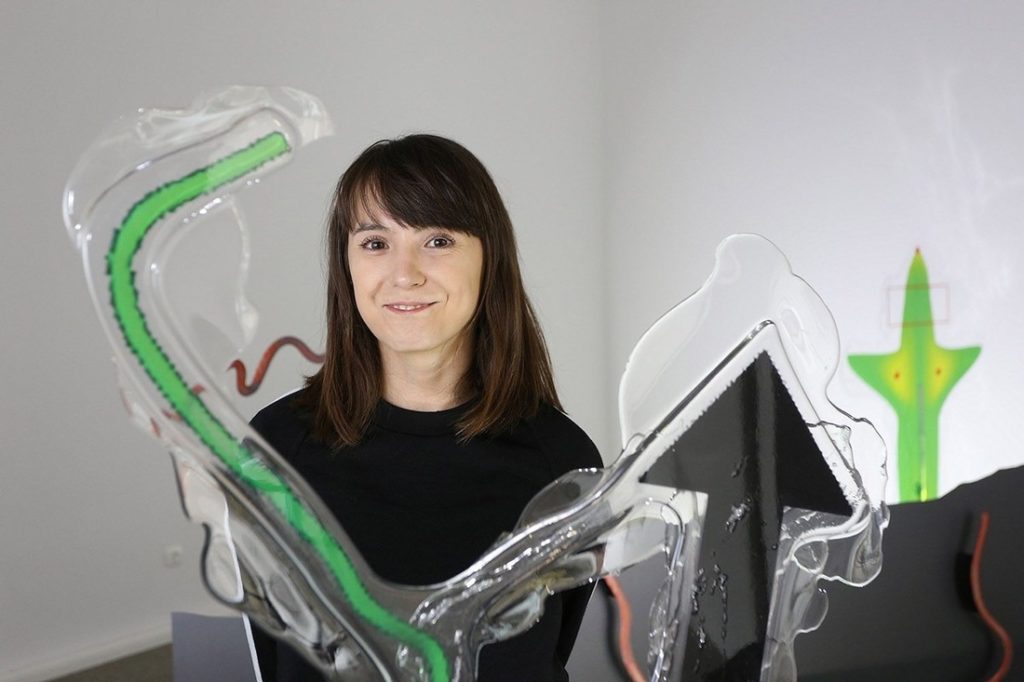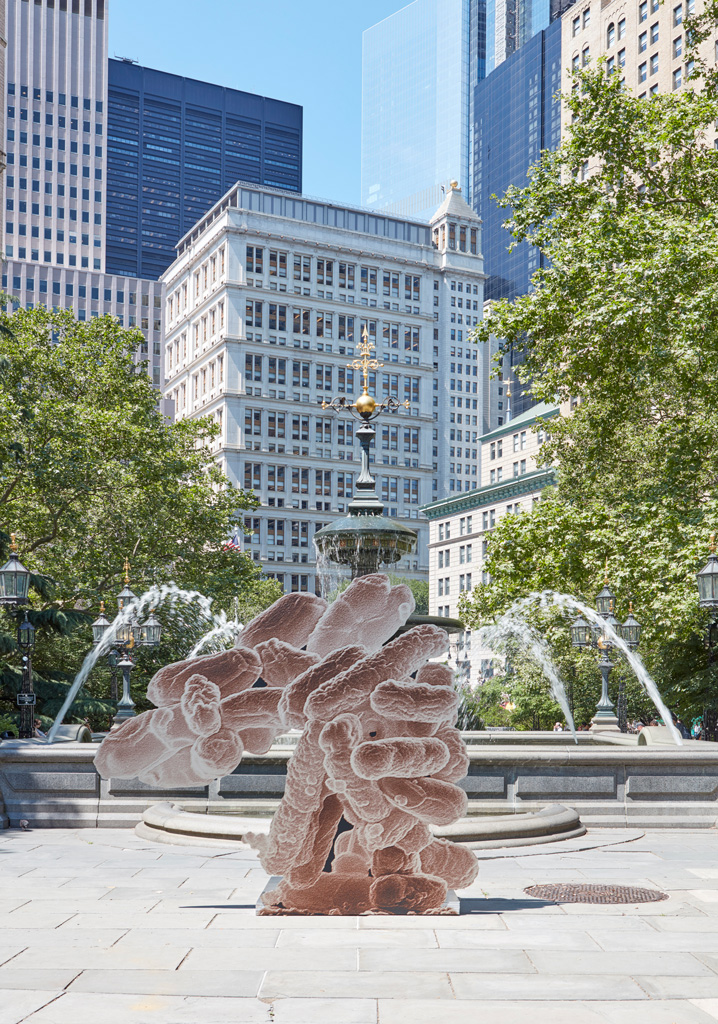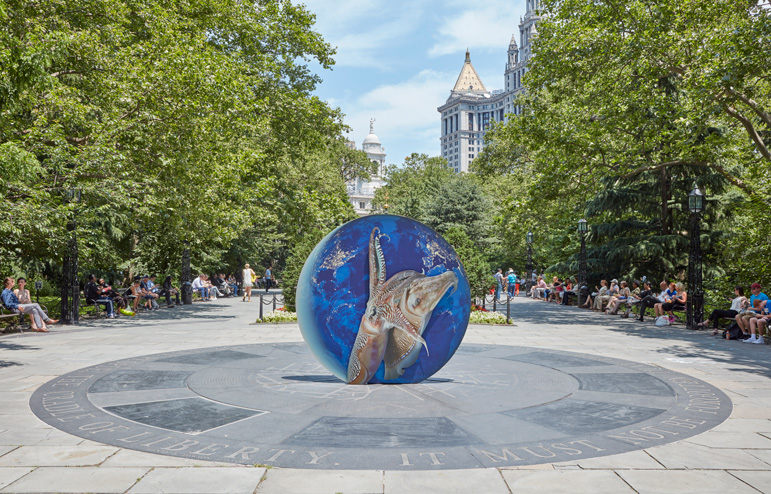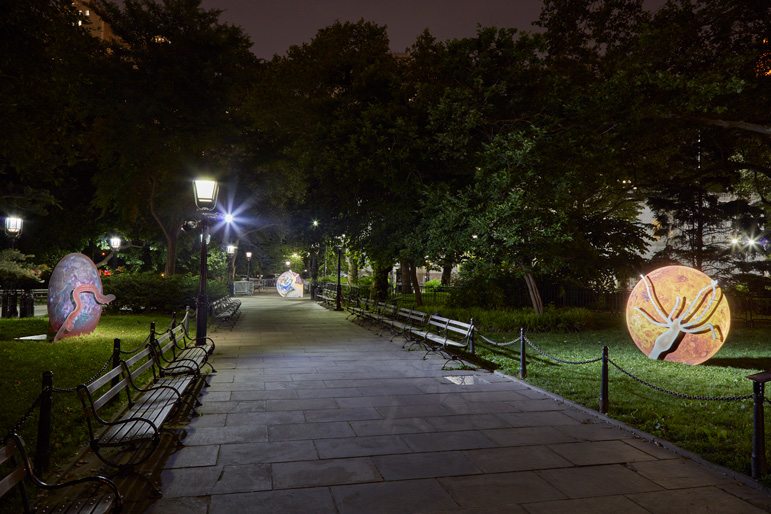

Why You Need to Know Estonian Artist Katja Novitskova
The up-and-coming talent has taken over Lower Manhattan with her eerie, sci-fi sculptures for Public Art Fund
Estonian artist Katja Novitskova was considering a metaphysical mystery at the Beekman Hotel bar in Lower Manhattan recently: her room key had disappeared. “The worst thing about being stressed all the time… it erases my memory of things,” she says. “This is Twin Peaks level.” Such assertions coincide with Novitskova’s spooky, uncanny aesthetic. For her exhibition at the Estonian Pavilion at the Venice Biennale (located at the Palazzo Malipiero San Samuele) this year, she fused electronic baby swings with robotic bugs. She’s also blown up digital images of insects to superhuman scales.

The artist cites Hieronymus Bosch, Salvador Dalí, and alien movies as early influences. She liked Dalí for “the running giraffes on fire and all this stuff,” and saw a relationship between his paintings and 3D renderings. Novitskova became interested in Bosch when, as a child, she and a friend discovered a book of his work. “We were really obsessed with this darkness and we were like satanists,” she recalls. “But we were around ten so it was probably very cute.” The pair drew crosses with upside down snakes and listened to metal music.

Born in 1984, Novitskova grew up in a milieu that celebrated strangeness. She explains how Estonia’s focus on cybernetics and computer sciences in the early 1960s generated a culture of horror and science fiction literature. These affinities are evident across the street from the hotel at City Hall Park, where Novitskova has installed seven large-scale aluminum sculptures in a project supported by the non-profit arts organization Public Art Fund (through November 9).
The pieces feature round, planetary digital prints with animals, or parts of animals, in front of them. Embryos, worms, cuttlefish, and hydras (sea creatures that intrigue the artist for their strange asexual reproductive techniques and near immortality) appear in arresting proportions. This is “biotech industrial complex imagery,” says Novitskova. “There are these themes of hybrids and mutants, and exploitation, and this freakish human dominance over nature.”

It’s a pleasure to watch New Yorkers in business suits, sitting on benches and eating sandwiches while a giant lizard hand lurks behind them. Novitskova, too, considers herself “a full-blown lurker.” She sources her digital images from online communities, though she never participates in their conversations or posts on their message boards.
For Novitskova, the sculptures are complete only when her audience interacts with them. “It was an experiment to see how it affects people,” she says, describing her artmaking as a kind of game to grab attention with a photo-triggering image. “It’s like this human response to trying to document it and post it somewhere immediately.” She believes that people conflate attention-grabbing images with “good art” and is more interested in her audience’s automatic response to unexpected biological forms, especially underappreciated animals like lab worms. Novitskova explains that there are thousands of images of worms online, as part of important scientific research processes. The resulting overabundance and new visual data culture particularly intrigue the artist.

Novitskova’s digital work, which requires just a laptop, can become lonely. Now, she’s now considering ways to make her practice more collaborative—perhaps by curating an exhibition with other artists, participating in panel discussions, or working with more writers. Yet, the loneliness seems to work for Novitskova conceptually as well. The eerie solitude of her organic shapes contributes to their appeal. In a busy park amid the people and objects we often take for granted, they offer striking reminders of our smallness in a vast, mysterious universe.
And despite the world’s uncertainties, Novitskova’s room key eventually appeared under a nearby table. One existential matter, at least, solved for the day.
“Earth Potential” runs through November 9 at City Hall Park.






